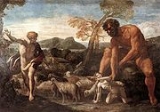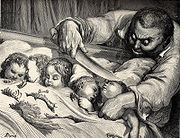
Ogre
Encyclopedia

Humanoid
A humanoid is something that has an appearance resembling a human being. The term first appeared in 1912 to refer to fossils which were morphologically similar to, but not identical with, those of the human skeleton. Although this usage was common in the sciences for much of the 20th century, it...
monster, featured in mythology
Mythology
The term mythology can refer either to the study of myths, or to a body or collection of myths. As examples, comparative mythology is the study of connections between myths from different cultures, whereas Greek mythology is the body of myths from ancient Greece...
, folklore
Folklore
Folklore consists of legends, music, oral history, proverbs, jokes, popular beliefs, fairy tales and customs that are the traditions of a culture, subculture, or group. It is also the set of practices through which those expressive genres are shared. The study of folklore is sometimes called...
, and fiction. Ogres are often depicted in fairy tales and folklore as feeding on human beings, and have appeared in many classic works of literature. In art, ogres are often depicted with a large head, abundant hair and beard, a voracious appetite, and a strong body. The term is often applied in a metaphorical sense to disgusting persons who exploit, brutalize, or devour their victims. Closely related is the troll
Troll
A troll is a supernatural being in Norse mythology and Scandinavian folklore. In origin, the term troll was a generally negative synonym for a jötunn , a being in Norse mythology...
figure, although these are sometimes not as malevolent.
Etymology

French language
French is a Romance language spoken as a first language in France, the Romandy region in Switzerland, Wallonia and Brussels in Belgium, Monaco, the regions of Quebec and Acadia in Canada, and by various communities elsewhere. Second-language speakers of French are distributed throughout many parts...
origin. Its earliest attestation is in Chrétien de Troyes
Chrétien de Troyes
Chrétien de Troyes was a French poet and trouvère who flourished in the late 12th century. Perhaps he named himself Christian of Troyes in contrast to the illustrious Rashi, also of Troyes...
' late 12th century verse romance Perceval, li contes del graal
Perceval, the Story of the Grail
Perceval, the Story of the Grail is the unfinished fifth romance of Chrétien de Troyes. Probably written between 1181 and 1191, it is dedicated to Chrétien's patron Philip, Count of Flanders...
, which contains the lines:
"And it is written that he will come again to all the realms of Logres
Logres
Logres is the name of King Arthur's realm in the Matter of Britain. It derives from the Welsh word Lloegr, a name of uncertain origin meaning "England"....
, known as the land of ogres, and destroy them with that lance." The ogres in this rhyme may refer to the ogres who, in the pseudohistorical work History of the Kings of Britain by Geoffrey of Monmouth
Geoffrey of Monmouth
Geoffrey of Monmouth was a cleric and one of the major figures in the development of British historiography and the popularity of tales of King Arthur...
, were the inhabitants of Britain prior to human settlement. Ogre could possibly derive from the two mythical giants Gog and Magog
Gog and Magog
Gog and Magog are names that appear primarily in various Jewish, Christian and Muslim scriptures, as well as numerous subsequent references in other works. Their context can be either genealogical or eschatological and apocalyptic, as in Ezekiel and Revelation...
(or from the Greek river god Oiagros
Oeagrus
In Greek mythology, Oeagrus , son of Pierus or Tharops, was a king of Thrace. He and the muse Calliope were the parents of Orpheus and Linus. He was also sometimes called the father of Marsyas. There are various versions as to where Oeagrus's domain was actually situated. In one version, he ruled...
, father of Orpheus
Orpheus
Orpheus was a legendary musician, poet, and prophet in ancient Greek religion and myth. The major stories about him are centered on his ability to charm all living things and even stones with his music; his attempt to retrieve his wife from the underworld; and his death at the hands of those who...
).
The word ogre came into wider usage in the works of Charles Perrault
Charles Perrault
Charles Perrault was a French author who laid the foundations for a new literary genre, the fairy tale, with his works derived from pre-existing folk tales. The best known include Le Petit Chaperon rouge , Cendrillon , Le Chat Botté and La Barbe bleue...
(1628–1703) or Marie-Catherine Jumelle de Berneville, Comtesse d' Aulnoy
Madame d'Aulnoy
Marie-Catherine Le Jumel de Barneville, Baroness d'Aulnoy , also known as Countess d'Aulnoy, was a French writer known for her fairy tales...
(1650–1705), both of whom were French authors. Other sources say that the name is derived from the word Hongrois, which means Hungarian, as of western cultures referred to hungarians as a kind of monstrosity. The word ogre is thought to have been popularized by the works of Italian author Giambattista Basile
Giambattista Basile
Giambattista Basile was an Italian poet, courtier, and fairy tale collector.- Biography :Born to a Neapolitan middle-class family, Basile was, during his career, a courtier and soldier to various Italian princes, including the doge of Venice. According to Benedetto Croce he was born in 1575, while...
(1575–1632), who used the Neapolitan word uerco, or in standard Italian, orco. This word is documented in earlier Italian works (Fazio degli Uberti, XIV cent.; Luigi Pulci
Luigi Pulci
Luigi Pulci was an Italian poet best known for his Morgante, an epic story of a giant who is converted to Christianity and follows the knight Orlando....
, XV; Ludovico Ariosto
Ludovico Ariosto
Ludovico Ariosto was an Italian poet. He is best known as the author of the romance epic Orlando Furioso . The poem, a continuation of Matteo Maria Boiardo's Orlando Innamorato, describes the adventures of Charlemagne, Orlando, and the Franks as they battle against the Saracens with diversions...
, XV-XVI) and has even older cognates with the Latin orcus
Orcus (mythology)
Orcus was a god of the underworld, punisher of broken oaths in Italic and Roman mythology. As with Hades, the name of the god was also used for the underworld itself. In the later tradition, he was conflated with Dis Pater, who was the Roman equivalent of Pluto.Orcus was portrayed in paintings in...
and the Old English orcnēas found in Beowulf
Beowulf
Beowulf , but modern scholars agree in naming it after the hero whose life is its subject." of an Old English heroic epic poem consisting of 3182 alliterative long lines, set in Scandinavia, commonly cited as one of the most important works of Anglo-Saxon literature.It survives in a single...
lines 112-113, which inspired J.R.R. Tolkien's Orc. All these words may derive from a shared Indo-European mythological concept (as Tolkien himself speculated, as cited by Tom Shippey
Tom Shippey
Thomas Alan Shippey is a scholar of medieval literature, including that of Anglo-Saxon England, and of modern fantasy and science fiction, in particular the works of J. R. R. Tolkien, about whom he has written several scholarly studies. He is widely considered one of the leading academic scholars...
, The Road to Middle-earth, 45). Some see the French myth of the ogre as being inspired by the real-life crimes of Gilles de Rais
Gilles de Rais
Gilles de Montmorency-Laval , Baron de Rais, was a Breton knight, a leader in the French army and a companion-in-arms of Joan of Arc. He is best known as a prolific serial killer of children...
.
The first appearance of the word ogre in Perrault's work occurred in his Histoires ou Contes du temps Passé (1697). It later appeared in several of his other fairy tales, many of which were based on the Neapolitan
Naples
Naples is a city in Southern Italy, situated on the country's west coast by the Gulf of Naples. Lying between two notable volcanic regions, Mount Vesuvius and the Phlegraean Fields, it is the capital of the region of Campania and of the province of Naples...
tales of Basile. The first example of a female ogre being referred to as an ogress is found in his version of Sleeping Beauty
Sleeping Beauty
Sleeping Beauty by Charles Perrault or Little Briar Rose by the Brothers Grimm is a classic fairytale involving a beautiful princess, enchantment, and a handsome prince...
, where it is spelled ogresse.
The Comtesse d' Aulnoy first employed the word ogre in her story L'Orangier et l' Abeille (1698), and was the first to use the word ogree to refer to the creature's offspring.
See also
- BugganeBugganeIn Manx mythology, a was a huge ogre-like creature, native to the Isle of Man.Bugganes were said to be covered in black hair, with claws, tusks and a large red mouth...
- CyclopsCyclopsA cyclops , in Greek mythology and later Roman mythology, was a member of a primordial race of giants, each with a single eye in the middle of his forehead...
- Ethereal creature
- Fictional ogres (category)
- GiantGiant (mythology)The mythology and legends of many different cultures include monsters of human appearance but prodigious size and strength. "Giant" is the English word commonly used for such beings, derived from one of the most famed examples: the gigantes of Greek mythology.In various Indo-European mythologies,...
- JikininkiJikininkiIn Japanese Buddhism, jikininki are the spirits of greedy, selfish or impious individuals who are cursed after death to seek out and eat human corpses. They do this at night, scavenging for newly dead bodies and food offerings left for the dead...
- MapinguariMapinguariThe mapinguari or mapinguary , also known as the Isnashi , is a legendary cryptid said to resemble a ground sloth-like creature with red fur living in the Amazon rainforests of Brazil and Bolivia...
- MonsterMonsterA monster is any fictional creature, usually found in legends or horror fiction, that is somewhat hideous and may produce physical harm or mental fear by either its appearance or its actions...
- Oni
- OrcOrcAn orc is one of a race of mythical human-like creatures, generally described as fierce and combative, with grotesque features and often black, grey or greenish skin. This mythology has its origins in the writings of J. R. R. Tolkien....
- ShrekShrek (character)Shrek is a fictional character from the children's book Shrek! and the Shrek films. He is the main protagonist of both the book and the films...
- TrollTrollA troll is a supernatural being in Norse mythology and Scandinavian folklore. In origin, the term troll was a generally negative synonym for a jötunn , a being in Norse mythology...
- WendigoWendigoThe Wendigo is a mythical creature appearing in the mythology of the Algonquian people. It is a malevolent cannibalistic spirit into which humans could transform, or which could possess humans...

